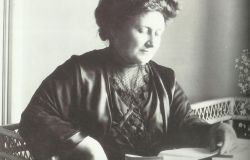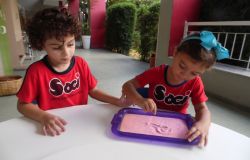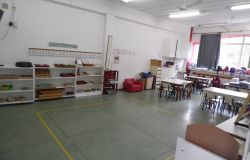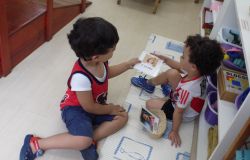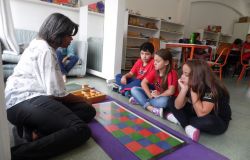Each person is unique and unique, able to live in community with the purpose of performing in the construction with the other. With this in mind, the Montessori System aims at the global learning of the child, with the aim of prioritizing the development and formation of a structure of concepts and values. Created in 1907 by Maria Montessori, the method, influenced by many thinkers of the time, revolutionized the educational context by presenting "the first work in human society guided by the child."
Aiming on the child and the development of its potentialities, the Montessori System has the following main characteristics: the scientifically formulated concrete material - an instrument of learning and connection between child and content - the prepared environment - that guides and allows free movement inside and outside the room – and multi-aging groupings of classes. The grouping classes obey the common associations of life. After all, the family, like every society, is also a "class" grouped with people of varying ages living on a daily basis.
The Montessori classes * at Saci School are multi-aging groupings: Grouping I (1 year and 4 months old to 2 years and 11 months old); Grouping II (3 to 5 years and 11 months old); Grouping III (6 to 8 years and 11 months old); Grouping IV (9 and 10 years and 11 months old). Thus, as in the cycle system, there is no disapproval within the period of these groups, which optimizes the evaluation efficiency in such an important period of cognitive development.
Different ages: There is great cognitive progress of younger and older children when working that way. The younger ones observe and are instigated to discover, to take the next step to some activities that the older ones perform, however, without hurry, because, after all, they still have two years to conquer / experience all the possibilities of knowledge that their class offers. On the other hand, older students feel important and responsible, and so they respond and share research and achievement or are just examples, when they perform actions that the younger ones observe and open their minds to that concept (this achievement receives the name of intuitive concept). In addition to the advance in the cognitive part, Montessori points out that multi-aging groupings promote the sense of community and family, in which elders learn their differences and can take care of the younger ones.
The Environment: is always child-centered, welcoming, prepared, adapted and with individually built competence. With a limited number of students, focused on their interest, abilities and potential, and with socialized context, the objective is to provide the possibility of adequate learning for children with three age groups, adapted to the local culture, which allows building student’s internal organization.
Learning: Students learn through interaction with the environment and available materials, which enable this interaction. Spontaneous activity is also encouraged, in order to provide for the growth, development and personality manifestation through autonomy. With this, the method predicts motivation and active learning, in which children define their learning interests. At the same time, it ends up building its own intelligence, in a process of self-education, since it chooses its activity and is driven by the need to be competent in it.
The teacher: the educator is the key element to the unleashing of the learning process and socialization in the class. Their presence in the prepared environment inspires safety and enthusiasm, empathy and firmness, being a reference for students when they need help to acquire knowledge. Also, with the function of an observer, the teacher has the capacity to infer the intentions of the students through observations, including him/herself, because he/she is always open to the world, without prejudices, and willing to welcome all. Being also a researcher, he/she must be ready for a continuous formation, capable of transforming, producing and creating new knowledge. For that matter, he/she has the great responsibility of nurturing the union between apprentices and knowledge.
Through the Montessori System, Saci International School believes in the development of moral beings, confident and competent learners, independent, autonomous, intrinsically motivated, academically prepared, socially responsible, spiritually aware and become citizens of the world and co-responsible for the planet. The acquisition of these skills and personality characteristics is working process for the whole life and Saci sees in Montessori education a process that initiates children into a community life and promotes these skills and characteristics, but does not end when leaving school.
* According to Maria Montessori, the age division in the groupings follows a plan of cognitive and psychosocial development that is stimulated when the class is organized with students from 0 to 3 years; 3 to 6 years old; 6 to 9 years old; 9 to 12 years old; 12 to 15 years old and 15 to 18 years old.
Aiming on the child and the development of its potentialities, the Montessori System has the following main characteristics: the scientifically formulated concrete material - an instrument of learning and connection between child and content - the prepared environment - that guides and allows free movement inside and outside the room – and multi-aging groupings of classes. The grouping classes obey the common associations of life. After all, the family, like every society, is also a "class" grouped with people of varying ages living on a daily basis.
The Montessori classes * at Saci School are multi-aging groupings: Grouping I (1 year and 4 months old to 2 years and 11 months old); Grouping II (3 to 5 years and 11 months old); Grouping III (6 to 8 years and 11 months old); Grouping IV (9 and 10 years and 11 months old). Thus, as in the cycle system, there is no disapproval within the period of these groups, which optimizes the evaluation efficiency in such an important period of cognitive development.
Different ages: There is great cognitive progress of younger and older children when working that way. The younger ones observe and are instigated to discover, to take the next step to some activities that the older ones perform, however, without hurry, because, after all, they still have two years to conquer / experience all the possibilities of knowledge that their class offers. On the other hand, older students feel important and responsible, and so they respond and share research and achievement or are just examples, when they perform actions that the younger ones observe and open their minds to that concept (this achievement receives the name of intuitive concept). In addition to the advance in the cognitive part, Montessori points out that multi-aging groupings promote the sense of community and family, in which elders learn their differences and can take care of the younger ones.
The Environment: is always child-centered, welcoming, prepared, adapted and with individually built competence. With a limited number of students, focused on their interest, abilities and potential, and with socialized context, the objective is to provide the possibility of adequate learning for children with three age groups, adapted to the local culture, which allows building student’s internal organization.
Learning: Students learn through interaction with the environment and available materials, which enable this interaction. Spontaneous activity is also encouraged, in order to provide for the growth, development and personality manifestation through autonomy. With this, the method predicts motivation and active learning, in which children define their learning interests. At the same time, it ends up building its own intelligence, in a process of self-education, since it chooses its activity and is driven by the need to be competent in it.
The teacher: the educator is the key element to the unleashing of the learning process and socialization in the class. Their presence in the prepared environment inspires safety and enthusiasm, empathy and firmness, being a reference for students when they need help to acquire knowledge. Also, with the function of an observer, the teacher has the capacity to infer the intentions of the students through observations, including him/herself, because he/she is always open to the world, without prejudices, and willing to welcome all. Being also a researcher, he/she must be ready for a continuous formation, capable of transforming, producing and creating new knowledge. For that matter, he/she has the great responsibility of nurturing the union between apprentices and knowledge.
Through the Montessori System, Saci International School believes in the development of moral beings, confident and competent learners, independent, autonomous, intrinsically motivated, academically prepared, socially responsible, spiritually aware and become citizens of the world and co-responsible for the planet. The acquisition of these skills and personality characteristics is working process for the whole life and Saci sees in Montessori education a process that initiates children into a community life and promotes these skills and characteristics, but does not end when leaving school.
* According to Maria Montessori, the age division in the groupings follows a plan of cognitive and psychosocial development that is stimulated when the class is organized with students from 0 to 3 years; 3 to 6 years old; 6 to 9 years old; 9 to 12 years old; 12 to 15 years old and 15 to 18 years old.




